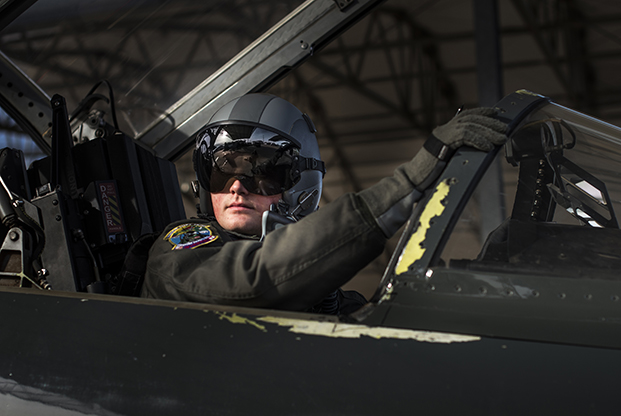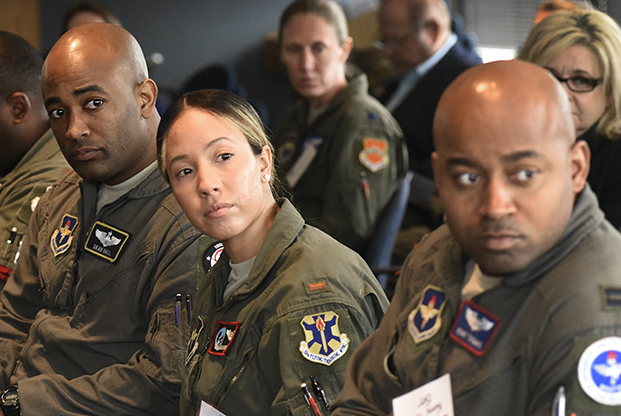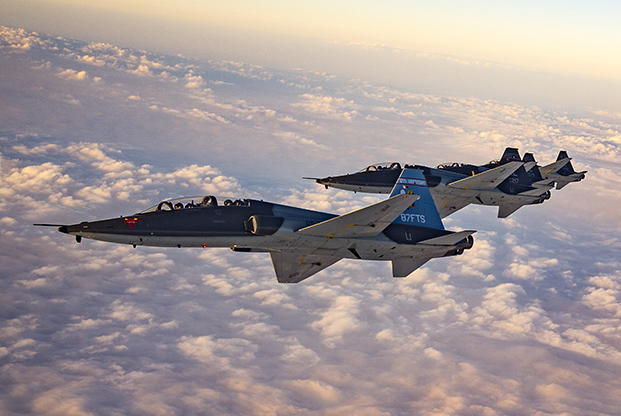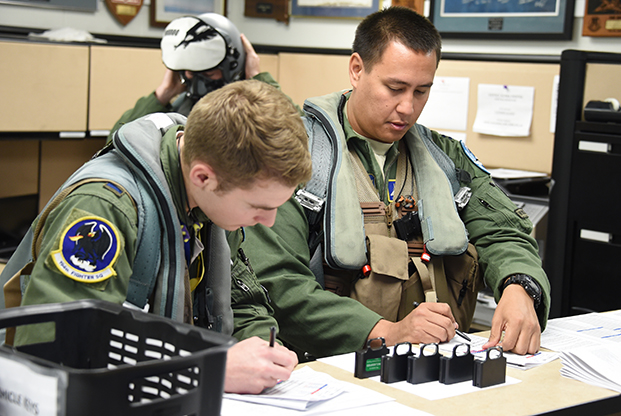
A pilot parks a T-38C Talon at Vance AFB, Okla. Photo: SrA. Corey Pettis.
The Air Force is short roughly 2,000 pilots, and the service is working 66 different initiatives it hopes will bring on larger numbers of new pilots and retain more the of the pilots it does have. Changes include financial incentives, quality of life improvements, and more flying time, Chief of Staff Gen. David L. Goldfein told House appropriators in March.
The service initially stood up a Fighter Enterprise Tiger Team in March 2016 to tackle the problem, but the effort eventually expanded to all rated personnel and the tiger team was renamed the Aircrew Crisis Task Force, with a one-star general leading the charge.
“As we’ve dug into the details and analyzed the issues, it really comes down to two areas that we are investing in and focused on,” said Goldfein. “One is how many pilots we produce; and then, two, how many pilots we retain, because you have to get both of those right.”
_Read this photoessay in our digital issue:
Air Education and Training Command produced 1,100 pilots in 2016 and 1,200 in 2017. In Fiscal 2018 the service was expected to put 1,235 students through undergraduate pilot training, but the recent month-long grounding of the T-6 Texan II, USAF’s primary trainer (due to hypoxia-like symptoms), means the service will miss its goal by about 200 student pilots, Goldfein told House appropriators. But because of the existing shortage, even 1,200 pilots will not get USAF’s force back in balance.
USAF hopes to reach that level in Fiscal 2019, Air Force Secretary Heather Wilson said at the same hearing. However, many programs, such as one under discussion that would push some students directly to the T-1 Jayhawk trainer, are still being worked. Undergraduate pilot trainees begin in the T-6 and then split off into either the T-38 Talon fighter/bomber track or the T-1 cargo/tanker/transport track.
USAF needs to produce at least 1,245 pilots per year in order to “steadily close the pilot shortage gap by the mid-2020s,” said Maj. Kenyatta Ruffin, the lead action officer in the Air Force’s Aircrew Crisis Task Force.

Attendees listen to Chief of Staff Gen. David Goldfein at the Air Force Association pilot shortage summit in early March. Photo: Mike Tsukamoto/Staff
Ruffin’s comment came at an Air Force Association-sponsored summit in March on the future of the Air Force pilot force. Members of the US military, from second lieutenants all the way to the Chief of Staff of the Air Force, along with representatives from academia and industry, got together to discuss new ways to attract, recruit, develop, and retain pilots.
One of the challenges discussed is the ability of the service to absorb the increased number of students moving through the pipeline.
It can take up to a year from the time a pilot graduates SUPT to being qualified in their fighter, Ruffin said. The remotely piloted aircraft community has a similar issue, he said, noting the RPA pipeline is a four-month program, but it’s currently taking about 18 months to complete because of the backlog.

T-38 Talons fly in formation over Texas during a sortie for the 87th Flying Training Squadron’s centennial flight celebration in August 2017. Photo: SrA. Keifer Bowes
In an effort to address “absorption limitations,” USAF is sending some inexperienced pilots to Naval Air Station Whidbey Island to fly E/A-18 Growlers for the US Navy. The move assists “the Navy with fighter pilot production pipeline issues and enhances tactical joint collaboration between the Navy and the Air Force,” according to a recent Government Accountability Office report. USAF also is working to get its newer fighter pilots more experience by sending them to its aggressor squadrons, where they play the bad guy against US and partner nations at major exercises like Red Flag and against student pilots at the US Air Force Weapons School, according to the report. Retention is another major issue. Goldfein and Wilson have said the service has no problem recruiting new pilots. The problems lie in training them, absorbing them, and getting them to stay past the midway point in their careers. Commercial airlines offer more money and less time away from their families. They hire about 4,500 pilots a year, and because regional airlines require at least 1,500 flying hours, experienced Air Force pilots represent a fertile recruiting ground.

1st Lt. Kevin Yoo, an instuctor pilot, preflights an aircraft before takeoff at Vance AFB. Photo: A1C Taylor Crul
Meanwhile, many female pilots also feel they must choose between flying fighters or having a family. Often the latter wins out.
During the AFA summit, Lt. Gen. Jacqueline D. Van Ovost, director of the Air Staff, said the Defense Department is looking at how it can give female pilots some time off when they have children. One possibility is to allow them access to the base, have them maintain proficiency through simulators, and roll back their “year group” so they remain competitive for assignments and promotions when they return to full-time service. The key to such a reset would be ensuring the women “actually go on and get command slots” when they come back to regular duty, said Van Ovost, a command pilot with 4,200 hours in both transport and fighter aircraft.
In October 2017, Air Combat Command adjusted its exercise plan enabling eight fighter wings to execute a one-to-five deploy-to-dwell ratio, “increasing time at home station for fighter pilots by 25-50 percent,” according to the GAO.

Pilots 1st Lt. Benjamin Martin (left) and Capt. Christopher Lacroix complete flight plans prior to a morning sortie during the joint exercise Sentry Aloha 18-01 at JB Pearl Harbor-Hickam, Hawaii. Photo: SMSgt. Chris Drudge/ANG
The service also has reduced many 365-day deployments to 179 days, limiting year-long fighter pilot deployments to those in command or Joint Staff assignments.
Last year, the Air Force also announced a Second Assignment In-Place Pilot Program, which allows a limited number of Active Duty, late-career fighter pilots and weapon system officers to remain at the same base for a second tour. The goal is to improve quality of life and potentially retain aviators with more than 20 years of experience, according to an Air Force press release. A similar program, dubbed Senior Pilot Transition Program, looks to transition experienced fighter pilot instructors to the F-35 community. Those selected for the program must agree to a three-year service commitment, but they don’t have to deploy.
“There is no silver bullet. It’s been death by a thousand cuts, so we have a thousand Band-Aids,” said Ruffin. “We have no shortage of ideas … it’s just coming up with prioritization, and resources, and the courage to take risk and do what we need to do.”
The Air Force will be “back above the floor when we can demonstrate to ourselves and the nation that we can produce 1,200 pilots per year for two years in a row,” he added.